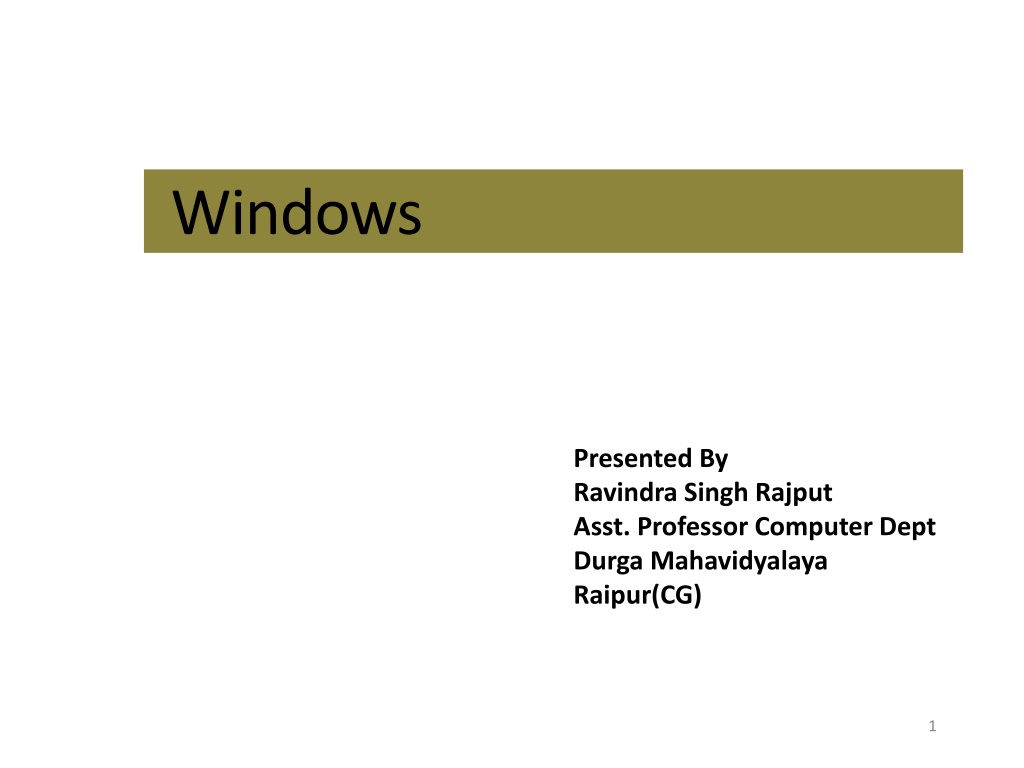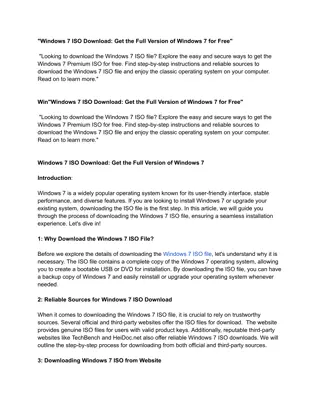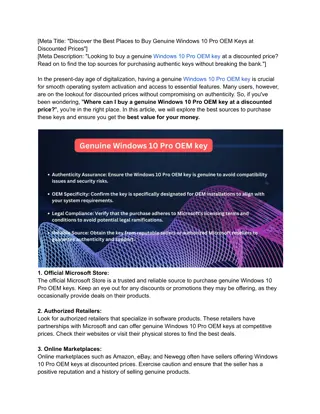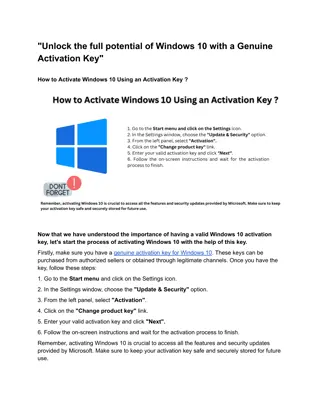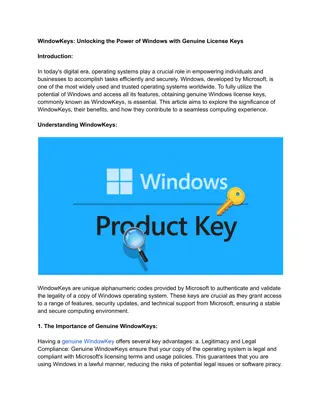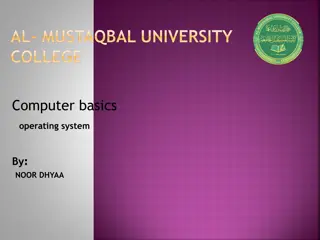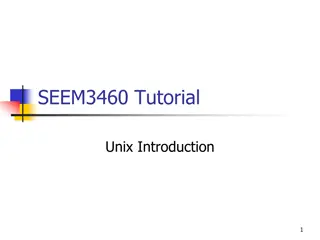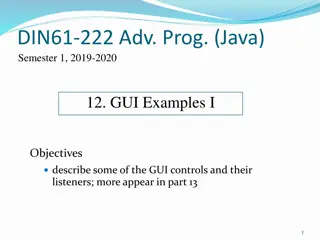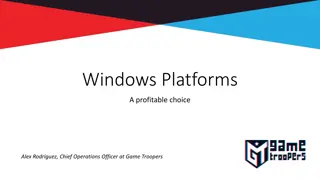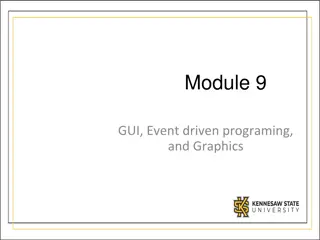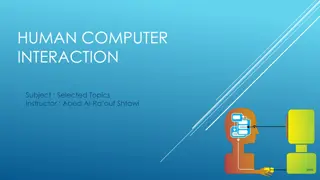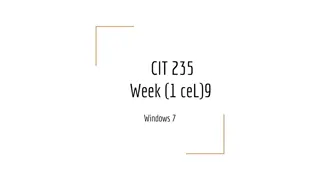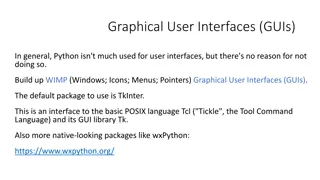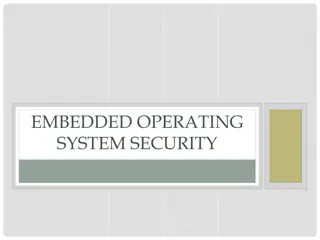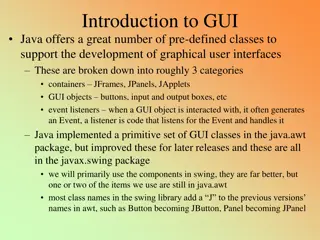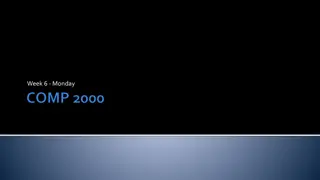Understanding GUI in Windows Operating System
Graphical User Interface (GUI) in Windows operating system is visually represented through icons, pointers, menus, and desktop elements. GUI standards ensure consistency across systems. Icons, cursors, and windows play key roles, allowing users to interact with applications efficiently. Learn how GUI simplifies user interactions in Windows.
Download Presentation

Please find below an Image/Link to download the presentation.
The content on the website is provided AS IS for your information and personal use only. It may not be sold, licensed, or shared on other websites without obtaining consent from the author. Download presentation by click this link. If you encounter any issues during the download, it is possible that the publisher has removed the file from their server.
E N D
Presentation Transcript
Windows Presented By Ravindra Singh Rajput Asst. Professor Computer Dept Durga Mahavidyalaya Raipur(CG) 1
Windows and Macare GUI s Microsoft Windows and Apple Macintosh operating systems are graphical user interfaces or GUI s. GUI is defined as: A picture used in place of a word or words to issue commands.
GUI Standards GUI interfaces have standards that are usually the same or similar in all systems and applications. Standards apply to: Pointers and pointing devices Icons, desktops, windows and menus
Windows - GUI Pointers GUI uses pictures, symbols, or icons rather than words to represent some object or function. For example: A pointer or mouse pointer is a small arrow or other symbol that moves on the screen as you move a mouse. An I-Beam pointer is used by many desktop publishing systems and word processors to mark blocks of text and move the insertion point.
GUI Cursors / Pointers The term cursor typically is used to show where your typing will appear. Otherwise, the term pointer is the better choice.
Windows - GUI Icons Icon - A small picture that represents a command, object, file, or window. Point and click with a mouse to execute a command or convert the icon into a window. Icons are moveable around the display screen, just like moving things around on your desk.
Object Icons & Shortcut Icons You can create and use a shortcut icon to open any One type of icon is an object icon. It allows you to open applications and documents on your PC. application quickly. You don t have to use the Start Menu to access a program or document.
Windows - GUI Windows & Desktop You can divide the screen into different areas. In each window, you can run a different program or display a different file. You can move windows around the display screen, and change their shape and size at will.
Windows - GUI Menus Menu - is an on-screen list of options for using a program. It can also be a list of categories with many other menu options under it. Menus can "pop up" or "pull down."
GUI Share Data Because the formats are well-defined, different programs that run under a common GUI can share data. This makes it possible, for example, to copy a graph created by a spreadsheet program into a document created by a word processor.
Parts of the Desktop
Windows - Taskbar Taskbar shows you the windows or programs that are currently open on the desktop. You can switch between windows by clicking on the applicable button.
Windows System Tray System Tray shows you running programs that were started automatically by the operating system, like anti-virus programs, the clock and volume controls. These programs are running in the background.
Windows - Quick Launch Toolbar Quick Launch Toolbar contains one-click buttons, or shortcuts, which open programs. You can customize this toolbar however you like.
Start Button The start button allows you to easily access your computer programs or configure Windows. By default the start button is located at the bottom left side of the screen.
Parts of a Window
Title Bar At the top edge of the window, inside its border, is the title bar which extends across the width of the window. It contains the title of the application or document. A small icon in the far left corner of the title bar represents the object being viewed in the window.
Minimize, Maximize and Resize Windows The title bar contains three little buttons in the upper right-corner of the window and are used to manage the window size or close it altogether.
Minimize - Maximize The first button is the minimize button and it will hide the window. The window can be opened again by clicking its button on the taskbar. The second button is maximize, which makes the window take up all the screen space. Clicking again turns the window back to the size it was. The double-box image is known as the restore button.
Close Window The last button will close a window. If it is the last window of a certain type of program, it will exit or quit that program.
Move a Window You can move a window to any location on the desktop by clicking and dragging the title bar with your mouse. This is also referred to as drag and drop . You can also drag and drop icons to move the location of files or shortcuts.
Menu Bar Menu bar - The horizontal bar near the top of a window that displays the names of menus from which you can access features and perform tasks for the current application.
Types of Menu Items Arrow: another menu will cascade from it. Three dots: a dialog box will open, containing choices for you to make.
Types of Menu Items Checkmark: clicking this item will toggle the feature on or off. If a keyboard shortcut is shown in the menu, you can use those keys to run the command without having to open the menu.
Scroll Bar Scroll bar - the narrow rectangular bar at the far right of windows. Clicking on the up or down arrow enables you to move up and down through a document. A movable square indicates your location in the document.
Windows Frame & Resizing You can also resize a window by a click and drag move. Put the mouse cursor on the edge of a window (that is not maximized) and when the pointer changes to a double arrow, click and drag for the new size. Some windows have a handle on them for resizing.
Status Bar Status bar is located at the bottom of a window and contains information about formatting options, errors, prompts, messages, or the status of an application.
Dialog Boxes 1. List box 2. Spin control box 3. Slide 4. Drop-down list 5. Radio button 6. Checkbox 7. Text box
Windows Start Menu programs and functions on your PC, including help files and search capabilities. Start Menu gives you access to all
Windows HELP Windows 95 HELP menu Access Windows HELP through the Start menu.
Windows 98 HELP menu Windows HELP
Windows HELP Windows XP HELP menu
Windows System Programs Windows has a number of internal programs as part of the operating system that help keep you organized and your PC healthy. Here are a few:
Windows - My Computer My Computer inside this icon you can find every folder and file that your PC has access to.
Windows Recycle Bin Recycle Bin Deleted files and folders go here first, where they wait to be permanently deleted by you, or by rules that you set up. This is a temporary storage area on your hard drive.
Windows My Docs My Documents a place to store the documents and files you create. Clicking on this opens an explorer window displaying the detail. It s wise to keep the files you create separate from the program files, so when you backup your data, it s all located in one location. You can then backup just this area of your storage.
My Documents Explorer Window
Windows Network Neighborhood Network Neighborhood serves as a window into the network resources you have on your PC. If you are connected to a network you will see all the other PC s linked to your network and you can share files, printers or other hardware.
Network Neighborhood
Logof f If your have multiple users on a PC with separate profiles or user logons, use the logoff process to close out of your profile or to switch users.
Shutdown Windows There is a graceful way of shutting down your PC that will save your program settings and files. This shutdown process basically puts the operating system to bed.
Which Explorer? Tip: Don't confuse Windows Explorer with Internet Explorer. Windows Explorer is the program that lets you explore things "inside" your own computer. Internet Explorer lets you explore things "outside" your computer -- namely things on the Internet.
